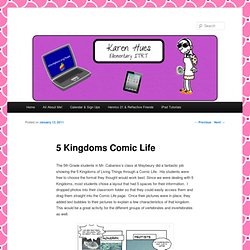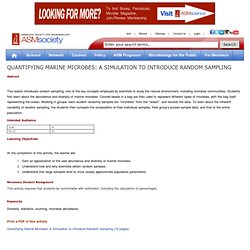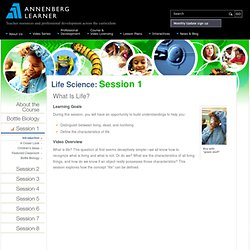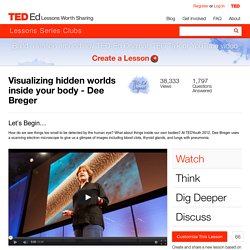

5 Kingdoms Comic Life. The 5th Grade students in Mr.

Cabaniss’s class at Maybeury did a fantastic job showing the 5 Kingdoms of Living Things through a Comic Life. His students were free to choose the format they thought would work best. Since we were dealing with 5 Kingdoms, most students chose a layout that had 5 spaces for their information. I dropped photos into their classroom folder so that they could easily access them and drag them straight into the Comic Life page.
Once their pictures were in place, they added text bubbles to their pictures to explain a few characteristics of that kingdom. Viruses. Quantifying Marine Microbes: A Simulation to Introduce Random Sampling. Abstract This lesson introduces random sampling, one of the key concepts employed by scientists to study the natural environment, including microbial communities.

Students first learn about the abundance and diversity of marine microbes. Colored beads in a bag are then used to represent different types of microbes, with the bag itself representing the ocean. Working in groups, each student randomly samples ten "microbes" from the "ocean", and records the data. To learn about the inherent variability of random sampling, the students then compare the composition of their individual samples, their group’s pooled sample data, and that of the entire population. Intended Audience Learning Objectives At the completion of this activity, the learner will: Gain an appreciation of the vast abundance and diversity of marine microbes.Understand how and why scientists obtain random samples.Understand that large samples tend to more closely approximate population parameters.
Necessary Student Background. MTS37 - Hazel Barton - Cave Dwellers. MTS46 - Curtis Suttle - It's a Virus World and We Just Live On It. MTS62 - Jessica Green - The Living Air. How Large is the Universe?
Life Science. Boy with "green stuff" Learning Goals During this session, you will have an opportunity to build understandings to help you: Distinguish between living, dead, and nonliving Define the characteristics of life Video Overview What is life?

Video Outline We open with a look at environments where you wouldn’t expect to find life and pose this question: "If you are looking for life, what do you look for? " The program continues as children in grades two and three are presented with a challenge: group objects as living, dead, or nonliving. In Brooklyn, New York, we visit LauraJo Kelly and her second-grade students as they generate their own definitions of living, dead, and nonliving and proceed to design experiments to test whether a “mysterious” object is alive.
Our search for an answer to the question "What is life? " Finally, Dr. The Science of Light : Made From Dots. Visualizing hidden worlds inside your body - Dee Breger. Here's the intro from Dee Breger's website: Welcome to the remarkable microworld, as seen through the scanning electron microscope (SEM).

These images are real photographs of things too small to see with our eyes, or even, in many cases, with the familiar optical microscope. I hope you enjoy your journey - especially through the gallery section - and I look forward to hearing from you! Scanning electron microscopes lord lots of advantages over optical microscopes, but they still can't produce color images. One way to add color is to use photo-processing software. More recently, however, scientists have developed an electron microscope with the ability to detect energy signatures emitted during the magnification process. Willard Wigan tells the story of how a difficult and lonely childhood drove him to discover his unique ability -- to create art so tiny that it can't be seen with the naked eye.
Winged Migration: Jacques Perrin, Philippe Labro, Jacques Cluzaud, Michel Debats, Andrea Occhipinti, Christophe Barratier, Danièle Delorme, Jean Labadie, Jean de Trégomain, Jean-Marc Henchoz, José María Morales, Reinhard Brundig, Francis Roux, Guy Jarry, Winogradsky columns: Microbial ecology in the classroom. How-big-is-the-universe-large.jpg 1,000×20,000 pixels. Synthetic Life Becomes Reality. Oxygen Theatre. Space School- Earth. "The Ring of Truth: Atoms" featuring Julia Child.